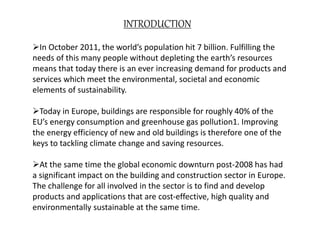The document discusses the use of plastics in building and construction. It notes that buildings are responsible for 40% of EU energy consumption and greenhouse gas emissions. Plastics can help meet EU targets for new buildings to be nearly zero-energy by 2021 through their use in insulation, windows, piping, and roofing, which saves energy and reduces costs. Plastics also have benefits like durability, light weight, ease of maintenance, and recyclability. The top three plastics used are polyvinyl chloride, polyethylene, and polystyrene in applications like pipes, insulation foam, and windows.














